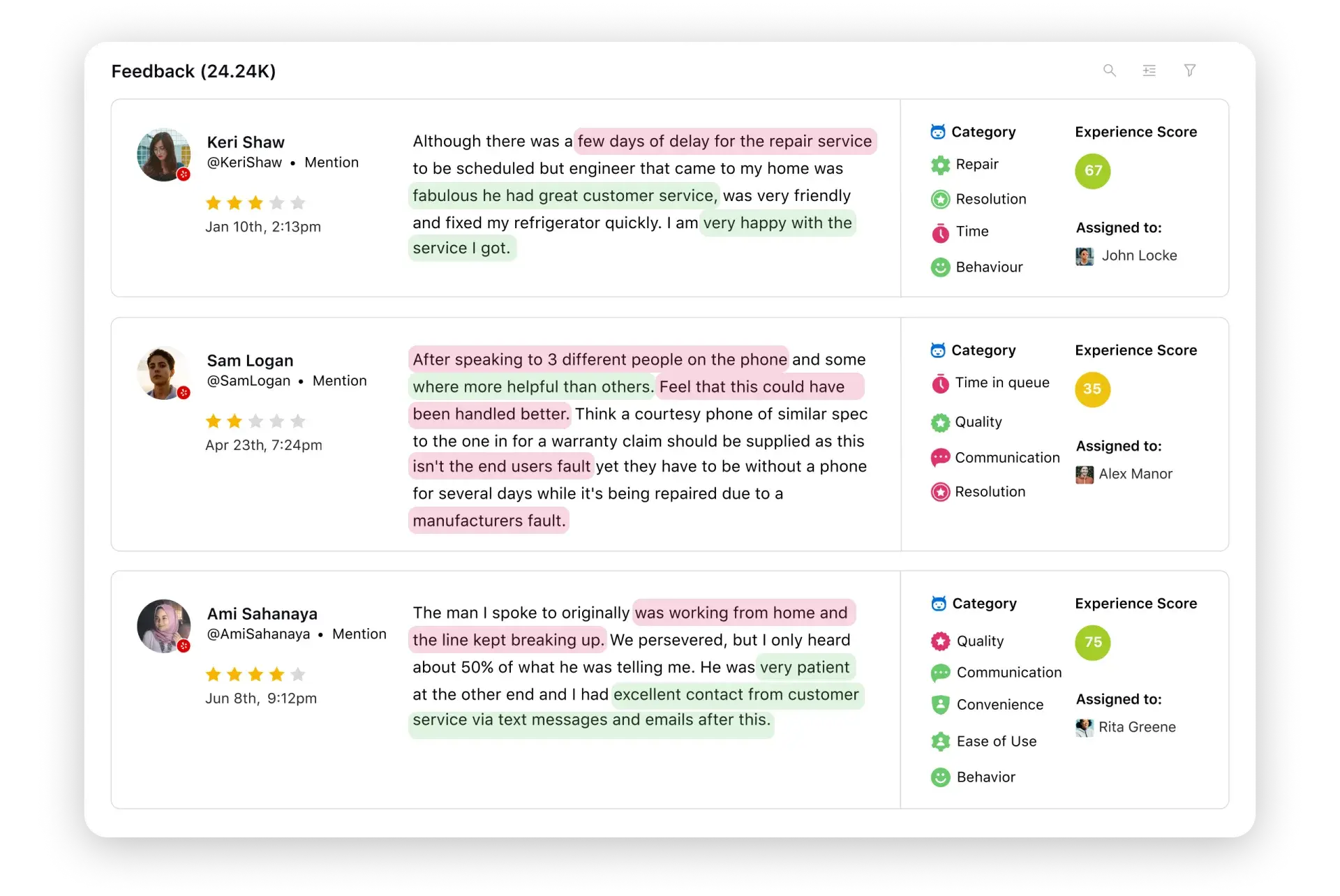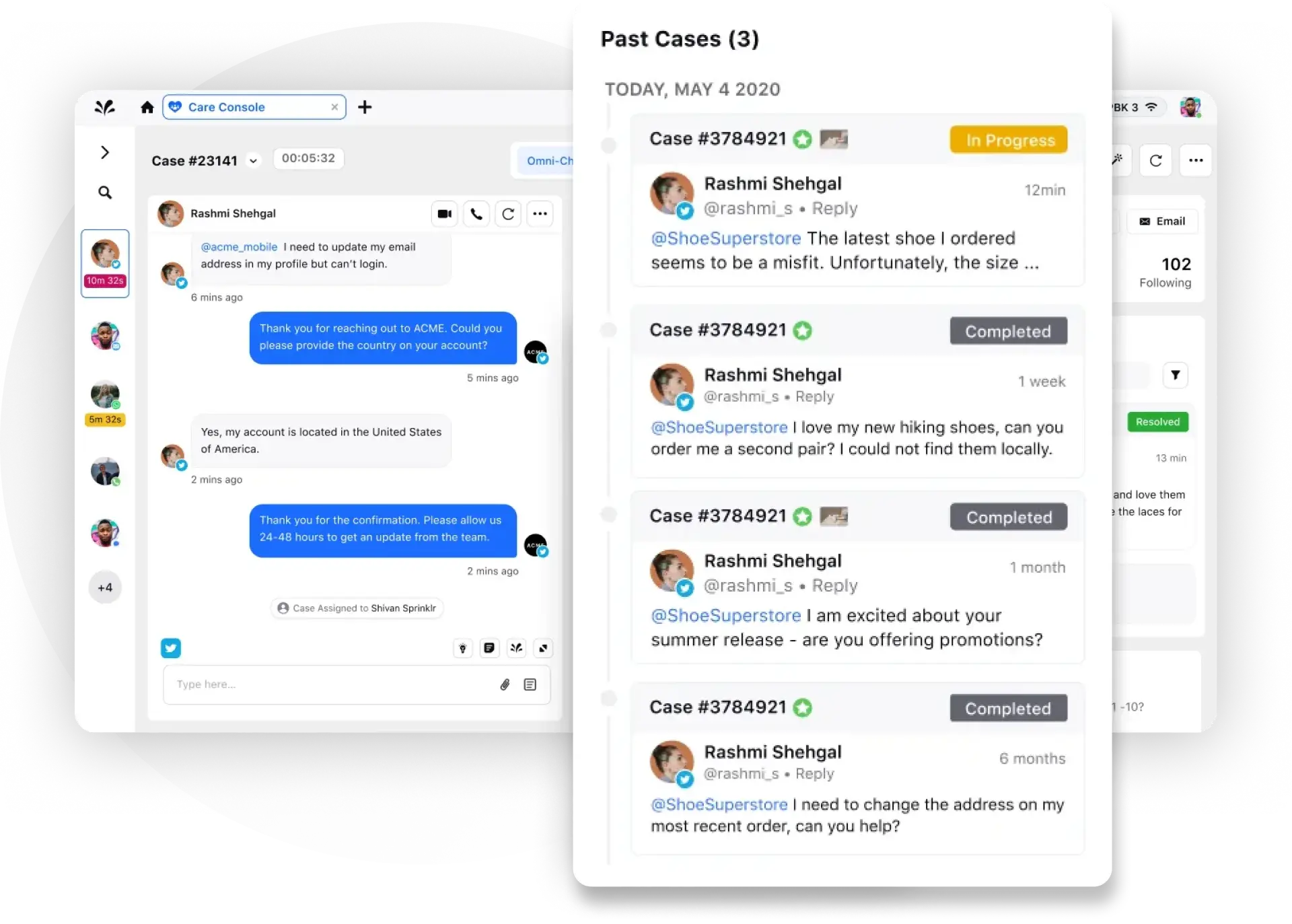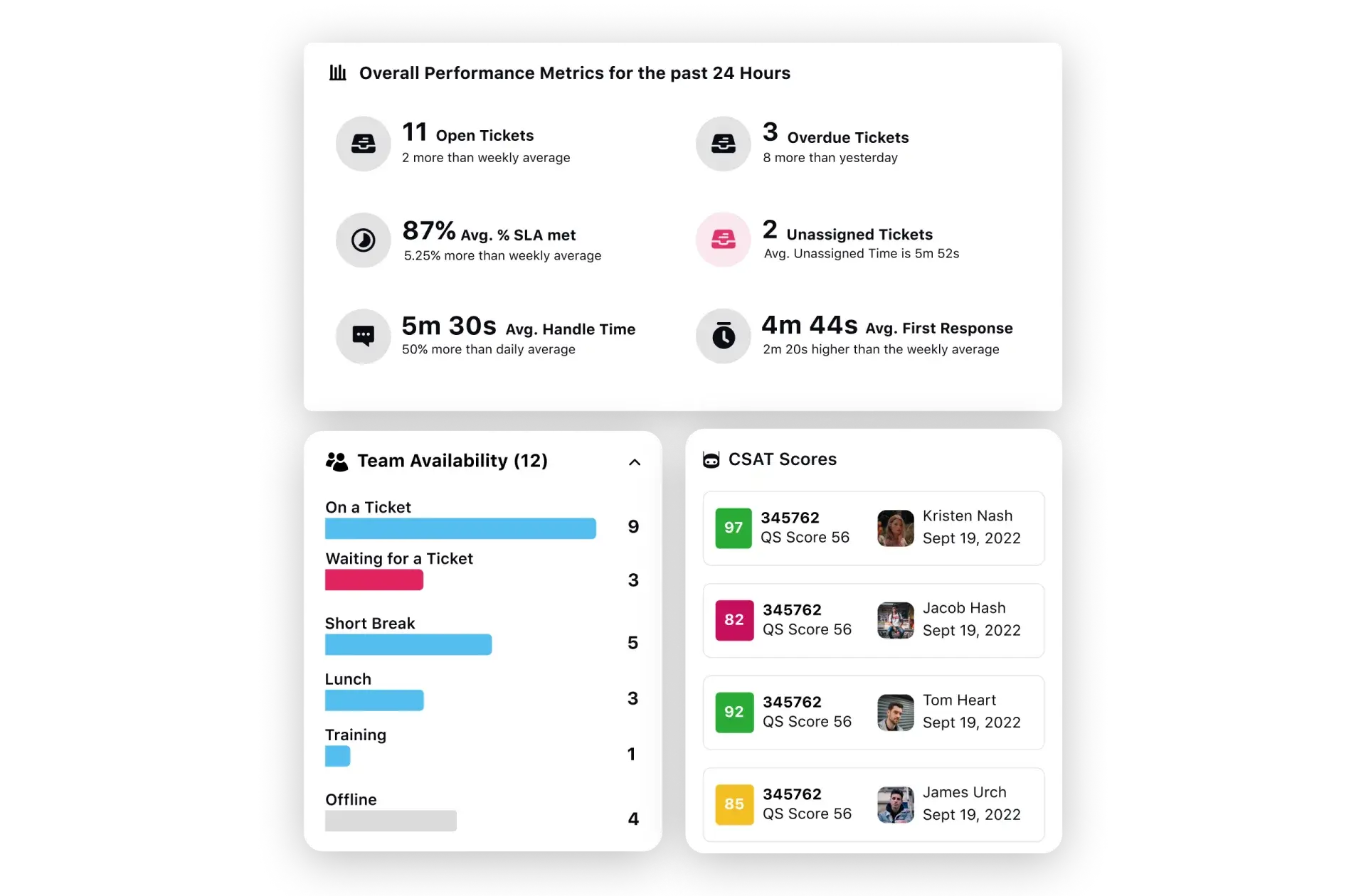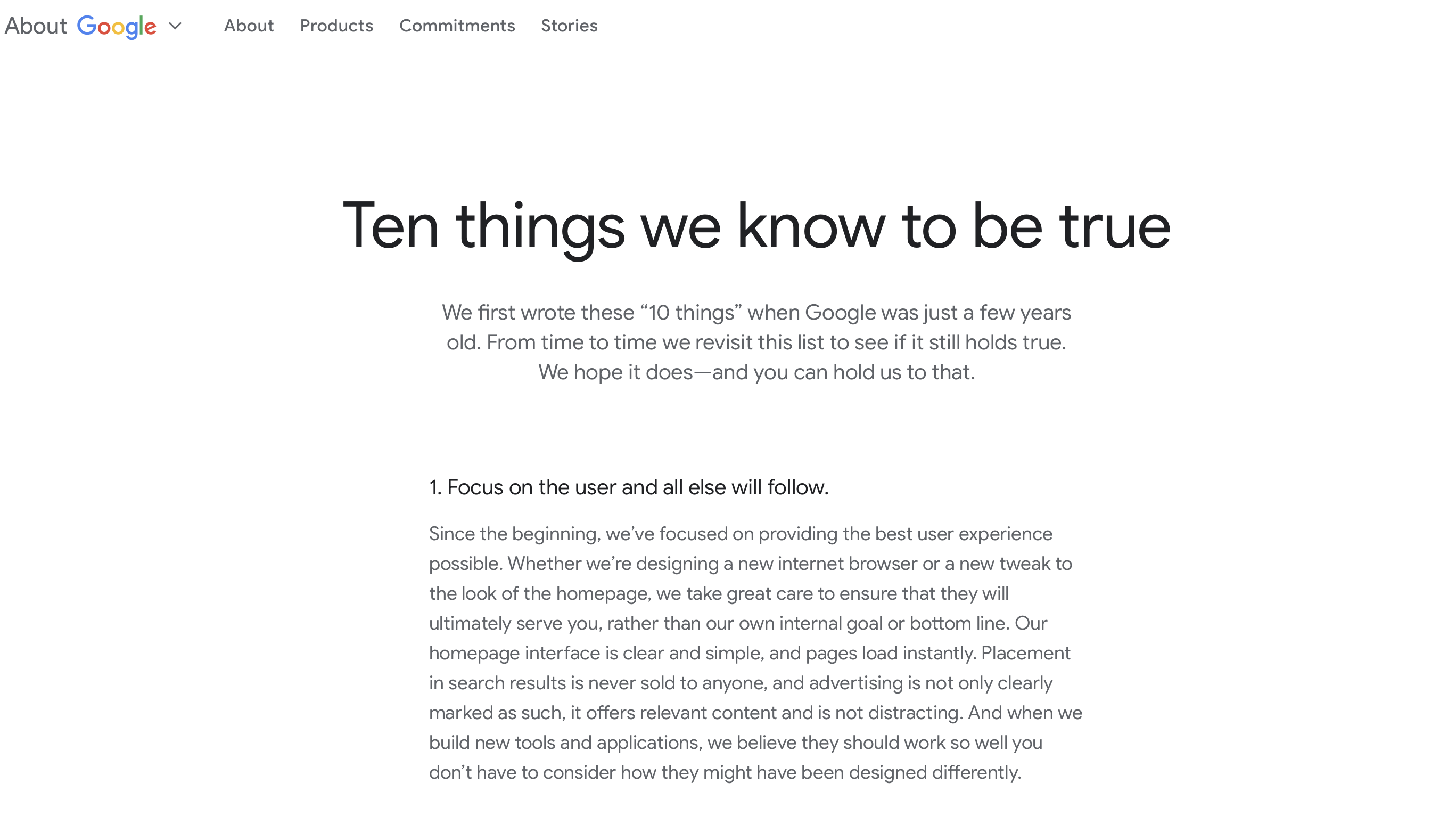What is customer focus?
Customer focus is a business approach that keeps your customers' needs, preferences and satisfaction at the center of your strategies and operations.
It goes beyond just delivering a product or service—it's about building a company culture centered around truly understanding your customers, fostering meaningful relationships with them and providing exceptional experiences that build customer loyalty.
Customer focus isn't relegated to an organization's singular department or function. The following examples illustrate the importance of customer focus in various areas of a business:
Product development: In product development, customer focus entails crafting solutions that directly address customer pain points and aspirations.
Consider a software company developing a new project management tool. While focusing on customers, the product team conducts extensive market research and collects feedback from potential users. They discovered that many users struggle with task prioritization and team collaboration. In response, the team implements customizable priority levels and real-time collaboration functionalities, directly addressing these pain points. This customer-centric approach ensures that the final product resonates deeply with the target audience, increasing adoption and customer satisfaction.Sales and marketing: Customer focus permeates every stage of the sales and marketing journey. From personalized outreach and tailored messaging to nurturing relationships post-purchase, these departments strive to align their efforts with customers' needs and preferences, ultimately creating brand advocates.
Customer support: Customer support is the front line in delivering exceptional customer experiences. Through prompt query resolution, customer empathy and proactive assistance, support teams not only resolve issues but also reinforce customer trust and satisfaction.
Research and development (R&D): R&D endeavors guided by customer focus yield innovations that directly address market demands and preferences.
Take the automotive industry as an example. A car manufacturer prioritizes customer focus in its R&D efforts. Analyzing customer feedback and market trends, they identify a growing demand for electric vehicles (EVs) with longer battery life and faster charging capabilities. In response, the R&D team focuses on developing advanced battery technology that significantly extends the range of EVs and reduces charging times.Customer success: Through proactive customer engagement, personalized guidance and value-driven initiatives, customer success teams ensure that customers derive maximum value from the product or service, fostering strong partnerships.
How does customer focus differ from customer experience
Customer focus requires enterprise leaders to embed a customer-centric mindset throughout the organization, from frontline staff to C-suite executives. Essentially, it functions as a compass that steers how businesses operate and make decisions, ensuring that customer satisfaction remains paramount in all endeavors.
In contrast, customer experience embodies the outcome of a customer service mindset. It encompasses every interaction, customer touchpoint and customer engagement with the business and reflects how well the organization meets or exceeds customer expectations at every stage of the customer journey.
Why must businesses build customer-focus
If you prioritize understanding and satisfying customer needs, you stand poised for sustainable growth and success. Here are other compelling reasons why cultivating customer focus is essential:
Drive customer satisfaction: One key reason customer focus is crucial is that it helps you drive customer satisfaction by truly understanding your target audience. You can gain insights into customer behaviors, preferences and pain points by investing time and resources into market research, collecting customer feedback and analyzing data. This knowledge allows you to tailor your products, services and marketing strategies to meet and exceed your customers' needs.
Retention and loyalty: Building solid and lasting customer relationships is critical to a successful business strategy. In today's market, customers have more choices than ever and they expect personalized experiences, exceptional customer service and brands that genuinely care about their needs. By prioritizing these elements, you can increase customer retention and build strong customer loyalty, ultimately setting your business up for long-term success.
💡Businesses that approach each touchpoint — from initial interactions to post-purchase support — with a sharp customer focus are more likely to create positive experiences and forge emotional connections with their audience.
Competitive advantage: In a crowded marketplace where products and services can appear similar, customer service and support level become key differentiators. By prioritizing customer focus and meeting and exceeding customer expectations, you can stand out as a leader in your industry, gaining a competitive edge and attracting more customers.
Reputation and brand Equity: Businesses renowned for their customer focus enjoy a strong reputation and enhanced brand equity. Positive customer experiences create a ripple effect, bolstering brand perception and attracting new customers through positive word-of-mouth referrals. Conversely, neglecting customer needs can erode brand trust, jeopardizing your brand reputation management efforts.
Good Read: 5 Steps to Build Brand Equity Using AI-driven Insights
9 tips to build a customer-focused business
To build a customer-focused business, you must ensure every department in your company works towards it, with each step centered around customers’ best interests. The tips and examples below will help you understand how to achieve client-centricity.
1. Understand customer requirements
Develop a comprehensive understanding of your customers by actively engaging in market research. Identify their preferences, pain points and expectations through customer surveys, focus groups and analyzing sentiments across customer service channels, including social media. Analyze purchasing patterns and trends to anticipate evolving needs, ensuring your products or services align with customer expectations.
By actively engaging in market research and analyzing customer feedback, you can stay attuned to evolving trends and consistently deliver value, creating positive experiences that resonate with your audience.
2. Develop a customer-centric culture
Instill a customer-centric mindset at every level of your organization, from frontline employees to senior leadership. Emphasize the importance of understanding customer needs, empathizing with their challenges and prioritizing their satisfaction in all business decisions.
Similarly, effective collaboration between departments is critical for delivering cohesive and integrated solutions to clients. Break down silos and encourage cross-functional teamwork to ensure a seamless and unified approach to serving client needs and delivering value. This approach reinforces a commitment to providing value throughout the customer journey.
3. Gather customer feedback regularly
Customer feedback is not a one-time transactional activity. Establish a systematic approach to collecting customer feedback on an ongoing basis. Utilize surveys, feedback forms and online reviews to gather running insights into customer experiences with your services and products. Act promptly on this feedback to address concerns, make improvements and demonstrate to customers that their opinions are valued and drive positive change.
📣Spread the word: Sprinklr's omnichannel survey software makes it possible to track customer feedback across more than 30 digital and social channels, including voice. Additionally, customer service leaders can use AI to monitor conversations for various signals and even predict CSAT scores in real time for ongoing discussions.

4. Personalize customer interactions
This may be an obvious step, but it's critical to leverage data to personalize customer interactions. Ensure your communication messages, promotions and recommendations are tailored to individual preferences, purchase history and behavioral data. This personalization enhances the overall user experience and strengthens the emotional connection between the customer and your brand.
Example: An online grocer leverages customer data to provide personalized recommendations based on a customer's weekly purchasing habits and food preferences. This helps create a unique, customized shopping experience that convinces customers that they are in the right hands.
5. Empower front-end teams
Invest in comprehensive training programs for front-end teams, including sales and contact center agents. Consider providing them with the necessary tools, knowledge and autonomy to handle customer interactions effectively. Equally important is demonstrating how customer focus drives positive outcomes for them and the business.
💡Pro Tip: Do you know that contact centers are facing increasing pressure to handle a growing number of calls while providing empathetic customer service and ensuring first-contact resolution? The good news is that modern AI-powered agent assist software offers a solution to this challenge. This innovative software provides agents with real-time suggestions for the next best action, similar resolved cases and relevant knowledge base articles during live calls. This enables agents to enhance the customer experience, reduce the average handle time and ensure compliance with service level agreements (SLAs).

6. Prioritize customer education
Break away from the mold that forces customer-brand interactions to be purely transaction. Customer focus means that brands must strive to add value to their customers even when they are not buying. You can do this by providing educational resources to empower customers. Develop comprehensive guides, tutorials and knowledge base to help customers better understand your products or services.
By actively educating your customers, you equip them to make informed decisions and maximize the value they receive.
Example: A fitness equipment brand offers online tutorials and guides to educate customers on the best workouts, targeted exercise videos and healthy meal plans. This builds customer loyalty and helps readers get the most out of their purchases.
7. Measure and monitor key customer service metrics
Establish clear customer service metrics for measuring customer satisfaction, retention and loyalty. Regularly track and analyze these metrics to gauge performance, identify areas for improvement and make data-driven decisions to enhance the overall client experience.
Good to know: With modern AI-powered reporting and analytics software, you gain actionable insights into your business operations at multiple levels. You can track key customer service metrics effortlessly, respond to critical events and deliver exceptional customer service in real-time.

8. Celebrate and showcase client success stories
Highlighting client success stories and testimonials showcases the value of your offerings and reinforces your commitment to client satisfaction. Celebrate client achievements and milestones, showcasing the tangible impact of your partnership on their business success.
9. Create employee incentives for increased customer focus
One of the ways to build a customer-centric culture is by linking employee incentives to customer satisfaction scores.
Acknowledge and reward exceptional customer service through bonuses, recognition programs or generous performance evaluations. You can also encourage a proactive approach to meeting customer needs by linking these rewards to customer-centric behaviors like better listening skills and in-depth research about a customer.
Incentivized employees are more likely to go the extra mile, ensuring customers feel valued and supported. Ultimately, a customer-focused workforce drives repeat purchases and promotes sustained growth for your business.
5 Examples of customer-focused businesses
Consistent efforts and improvements are essential to build a customer-focused brand. Let's explore brands that prioritize their customers.
1. Slack

Slack stands out as an example of putting customers first. It all started with identifying a familiar frustration – the chaos of internal communication and never-ending email threads within organizations.
Listening to customers has been Slack's guiding principle. Instead of just chasing profits, it prioritizes customer metrics such as NPS and CES. This customer-centric approach has proven successful, and Slack serves millions of daily users.
2. Starbucks

Listening to customers influenced Starbucks' ordering procedure. Since its clients frequently rush to get a coffee before heading to work or school, the company incorporated quick mobile ordering through its app. Customers can then pick up their orders without having to wait in line.
However, Starbucks continues to provide in-store ordering to avoid losing clients who prefer a more relaxed and casual cafe experience. It also developed a loyalty program to express gratitude to its regular clients.
3. Google

Google cares a lot about its users, and its motto, "Focus on the user and all else will follow," shows that. It pays attention to how people use its services and makes its search engine fast by adjusting things in the background. Google is constantly revising its search engine algorithm so users have the best, most value-added and intuitive experience.
This commitment to making users happy has made Google the top choice for technology.
4. Amazon

Amazon's commitment to putting customers first is evident in founder Jeff Bezos' words, "I would define Amazon by our big ideas, which are customer centricity, putting the customer at the center of everything we do." The company has mastered the art of enhancing customer experience in various ways:
Amazon streamlines the ordering process, ensuring it's quick and straightforward. Its emphasis on fast and hassle-free delivery has set a hard-to-beat benchmark for customer convenience.
The company actively leverages customer data to provide personalized experiences. Shoppers receive real-time assistance with product selections based on their browsing and buying history, making each interaction tailored to the individual.
Amazon goes the extra mile to assist customers in finding the best deals. Whether through promotions, discounts or recommendations, the focus is on ensuring customers feel they are getting the best value for their money.
5. McDonald's

When Steve Easterbrook became McDonald's CEO in 2015, he ushered in a new era of customer-centricity.
Battling stiff competition and changing consumer preferences, McDonald's adopted a proactive approach, actively seeking and acting on customer feedback. Using channels like social media and online surveys, the fast-food giant identified customer desires, introducing healthier menu options, localized food options in countries, extended opening hours and the popular 'All Day Breakfast' in select US stores.
This customer-focused strategy, grounded in social listening data, addressed evolving preferences and revitalized McDonald's in the competitive fast-food landscape.
Prioritizing customer needs is not just about delivering products or services; it's about cultivating lasting relationships that drive advocacy and foster brand loyalty. By adopting a customer-focused approach, you can become a better listener, a more empathetic provider and a trusted name in your customers' eyes.
The guide provides a practical roadmap to help you build a customer-focused culture with tangible outcomes. To take the next step in implementing these strategies and transforming your business, consider scheduling a consultation with our team today.
Frequently Asked Questions
related products
Thank you for contacting us.
A Sprinklr representative will be in touch with you shortly.
Contact us today, and we'll create a customized proposal that addresses your unique business needs.
Request a Demo
Welcome Back,
No need to fill out any forms — you're all set.


